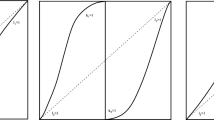Abstract
We study the asymptotic expansion of the topological pressure of one–parameter families of potentials at a point of non-analyticity. The singularity is related qualitatively and quantitatively to non–Gaussian limit laws and to slow decay of correlations with respect to the equilibrium measure.
Similar content being viewed by others
References
Aaronson J., Denker M., Urbański M. (1993). Ergodic theory for Markov fibred systems and parabolic rational maps. Trans. AMS 337:495–548
Aaronson J., Denker M. (2001). Local limit theorems for partial sums of stationary sequences generated by Gibbs-Markov maps. Stoch. Dyn. 1(2):193–237
Bálint P., Gouëzel S. (2006). Limit theorems in the stadium billiard. Commun. Math. Phys. 263, 2, 461–512
Bingham N.H., Goldie C.M., Teugels J.L. (1987). Regular variation. Encyclopedia of Math. and its Appl. 27, Cambridge Univ. Press, Cambridge
Binney J.J., Dowrick N.J., Fisher A.J., Newman M.E.J. (1992). The theory of critical phenomena, an introduction to the renormalization group. Oxford Science Publications, Oxford University Press, Oxford
Bowen R. (1975). Equilibrium states and the ergodic theory of Anosov diffeomorphisms. Lecture Notes in Mathematics, Vol. 470. Springer-Verlag, Berlin-New York
Buzzi J., Sarig O. (2003). Uniqueness of equilibrium measures for countable Markov shifts and multi-dimensional piecewise expanding maps. Erg. Th. Dynam. Sys. 23:1383–1400
Eagleson, G.K.: Some simple conditions for limit theorems to be mixing. (Russian) Teor. Verojatnost. i Primenen. 21(3), 653–660 (1976) Engl. Transl. in Theor. Probab. Appl. 21(3), 637–642 (1976)
Ellis R.S. (1985). Entropy, large deviations, and statistical mechanics. Grund. Math. Wissenschaften 271, Springer Verlag, Berlin Heidelberg-Newyork
Feller W. (1971). An introduction to probability theory and its applications Volume II, Second edition. John Wiley & Sons, Newyork
Fisher M.E., Felderhof B.U. (1970). Phase transition in one–dimensional cluster–interaction fluids: IA. Thermodynamics, IB. Critical behavior. II. Simple logarithmic model. Ann. Phy. 58:177–280
Gnedenko, B.V., Kolmogorov, A.N.: Limit distributions for sums of independent random variables. Translated and annotated by K.L. Chung, with an Appendix by J.L. Doob. Readings MA: Addison–Wesley Publishing Company, 1954
Gouëzel S. (2004). Sharp polynomial estimates for the decay of correlations. Israel J. Math. 139:29–65
Gouëzel S. (2004). Central limit theorem and stable laws for intermittent maps. Probab. Theory Related Fields 128(1):82–122
Gurevič B.M. (1969). Topological entropy of a countable Markov chain. Dokl. Akad. Nauk SSSR 187:715–718
Gurevich B.M. (1984). A variational characterization of one-dimensional countable state Gibbs Random field. Z. ahrscheinlichkeitstheorie verw. Gebiete 68:205–242
Haydn N., Isola S. (2001). Parabolic rational maps. J. London Math. Soc. 63(2):673–689
Hilfer R. (1993). Classification theory for anequilibrium phase transitions. Phys. Rev. E 48(4):2466–2475
Hofbauer F. (1977). Examples for the non–uniqueness of the equilibrium states. Trans. AMS 228:223–241
Kato T. Perturbation theory for linear operators Reprint of the 1980 edition. Classics in Mathematics.Berlin: Springer-Verlag, (1995).
Keane M. (1972). Strongly mixing g-measures. Invent. Math. 16:309–324
Lopes A.O. (1993). The Zeta function, non–differentiability of pressure, and the critical exponent of transition. Adv. Math. 101(2):133–165
Martin–Löf A. (1973). Mixing properties, differentiability of the free energy and the central limit theorem for a pure phase in the Ising model at low temperature. Commun. Math. Phys. 32:75–92
Urbański M., Mauldin R.D. (2001). Gibbs states on the symbolic space over an infinite alphabet. Israel J. Math. 125:93–130
Mauldin, R.D., Urbański, M.: Graph directed Markov systems; Geometry and dynamics of limit sets. Cambridge Tracts in Mathematics, 148, Cambridge: Cambridge University Press, Cambridge, 2003.
Melbourne I., Török A. (2004). Statistical limit theorems for suspension flows. Israel J. Math. 194:191–210
Nagaev S.V. (1957). Some limit theorems for stationary Markov chains. (Russian) Teor. Veroyatnost. i Primenen. 2:389–416
Prellberg T., Slawny J. (1992). Maps of intervals with indifferent fixed points: thermodynamic formalism and phase transitions. J. Stat. Phys. 66(1–2):503–514
Ruelle D. (2004). Thermodynamic Formalism, The mathematical structures of equilibrium statistical mechanics. 2nd Ed. Cambridge Mathematical Library. Cambridge University Press, Cambridge
Sarig O.M. (1999). Thermodynamic Formalism for Countable Markov shifts. Erg. Th. Dyn. Sys. 19:1565–1593
Sarig O. (2001). Phase Transitions for Countable Markov Shifts. Commun. Math. Phys. 217:555–577
Sarig O. (2003). Characterization of existence of Gibbs measures for Countable Markov shifts. Proc. of AMS. 131(6):1751–1758
Sarig O. (2001). Thermodynamic formalism for null recurrent potentials. Israel J. Math. 121:285–311
Sarig O. (2002). Subexponential decay of correlations. Invent. Math. 150:629–653
Sarig, O.: Thermodynamic formalism for countable Markov shifts. Tel-Aviv University Thesis (2000).
Sarig O. (2000). On an example with a non-analytic topological pressure. C. R. Acad. Sci. Paris Sér. I Math. 330(4):311–315
Stanley H.E. (1971). Introduction to phase transitions and critical phenomena. Oxford University Press, Oxford
Walters P. (1975). Ruelle’s operator theorem and g-measures. Trans. Amer. Math. Soc. 214:375–387
Wang, X.-J.: Abnormal fluctuations and thermodynamic phase transition in dynamical systems. Phys. Review A 39(6), 3214–3217
Wang X.-J. (1989). Statistical physics of temporal intermittency. Phys. Review A 40(11):6647–6661
Yuri M. (2003). Thermodynamic formalism for countable to one Markov systems. Trans. Amer. Math. Soc. 355(7):2949–2971
Yuri M. (2005). Phase transition, non-Gibbsianness and subexponential instability, Ergodic Thy Dynam. Syst. 25:1325–1342
Zolotarev V.M. (1986). One–dimensional stable distributions. Transl. Math. Monog. 65, Amer. Math. Sec., Providence, RI
Author information
Authors and Affiliations
Corresponding author
Additional information
Communicated by G. Gallavotti
Dedicated to Y. Pesin on the occasion of his 60th birthday
This work was partially supported by NSF grant DMS–0400687.
Rights and permissions
About this article
Cite this article
Sarig, O. Continuous Phase Transitions for Dynamical Systems. Commun. Math. Phys. 267, 631–667 (2006). https://doi.org/10.1007/s00220-006-0072-7
Received:
Accepted:
Published:
Issue Date:
DOI: https://doi.org/10.1007/s00220-006-0072-7




